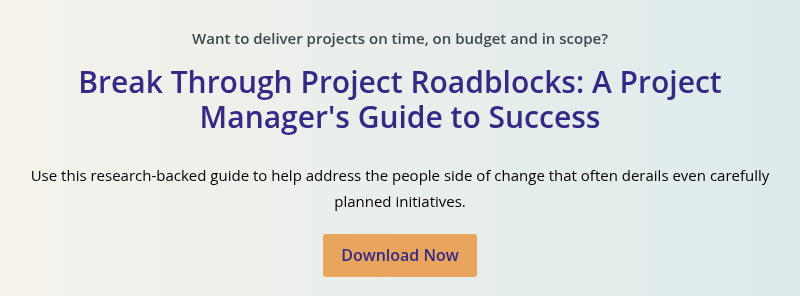Integrating Change Management and Project Management

6 Mins
Updated: August 7, 2025
Published: May 14, 2025

Change management and project management are complementary disciplines that together drive successful organizational initiatives. By integrating these approaches from start to finish, you connect the people side and technical side of change, ensuring your organization realizes the full benefits of transformation.
A Unified Value Proposition
Prosci's Unified Value Proposition model illustrates how project management and change management work together with a shared definition of success: meeting or exceeding project objectives and realizing organizational benefits.
- Technical side: Focused on designing, developing and delivering solutions that address problems or opportunities. Project management provides the structure, processes and tools to accomplish this.
- People side: Centered on engaging impacted individuals and supporting them to adopt and use the change effectively. Change management provides the framework to achieve this outcome.
Prosci Unified Value Proposition
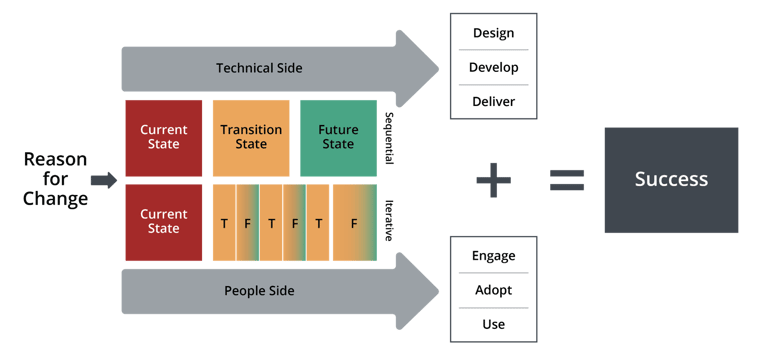
Think of these disciplines as two different colored strands of rope. When intertwined, they create a stronger, more resilient rope—just as integrated change and project management deliver more successful transformations.
How Integration Creates Value
Prosci benchmarking research shows that 47% of participants who integrated project management and change management reported meeting or exceeding project objectives—17% more than those who didn't integrate these disciplines.
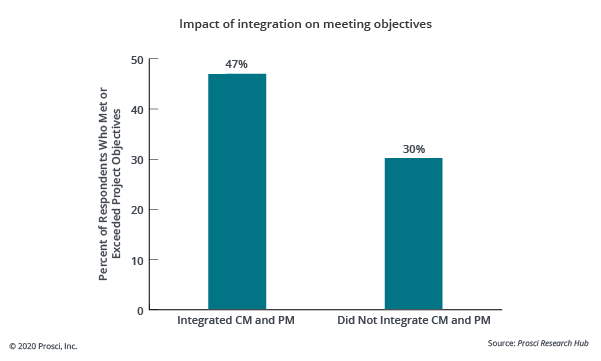 Integrating change management and project management contributes to change success by:
Integrating change management and project management contributes to change success by:
- Creating a shared objective: Both disciplines focus on improving organizational performance through successfully implemented changes that deliver intended results.
- Enabling proactive approaches: Integration helps you identify and mitigate risks earlier, address resistance, and build commitment to change adoption.
- Improving sequencing and alignment: The right actions happen at the right times in the project lifecycle, ensuring people are ready and able to adopt the change.
- Enhancing information exchange: Throughout the project, stakeholders receive the information they need when they need it, from understanding the need for change to providing feedback on adoption.
5 Dimensions of Integrating Change Management and Project Management
Prosci’s research reveals five dimensions that should be addressed when integrating change management and project management:
Dimension 1: People
This dimension focuses on who performs change and project management roles and the team structure defining relationships between these roles. In Prosci's Best Practices in Change Management research, 69% of participants had dedicated change management resources for the project on which they were reporting.
The basic structures include:
- Change management resources on the project team (Team Structure A - used by 33% of participants)
- Change management resources supporting the project team externally (Team Structure B)
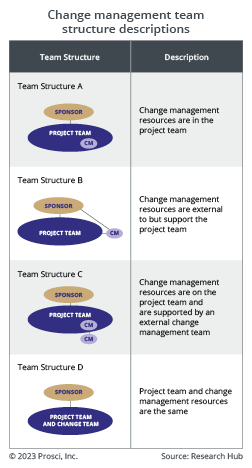
Neither structure is inherently better—each offers different advantages. For example, having the change management resources on the project team (Team Structure A) encourages more transparent communications and information flow between the team and the impacted groups. Other advantages include developing an integrated project approach that encourages teamwork and collaboration, and the creation of feedback loops to relay questions and concerns from impacted groups to the project team.
Having the change management resources separate from but supporting the project team externally (Team Structure B), promotes neutrality and enables them to offer an independent point of view. Other advantages include the ability to focus exclusively on change management and direct access to leadership.
The choice of integration approach is typically based on the nature of the project and norms of the organization. It’s important to acknowledge that many change practitioners do not have control over or major influence on the selection of the team structure used on a particular project. For example, the team structure may already be established before the change resources are selected.
Even if the team structure has already been established, there are actions you can take to support the effective integration of people and roles.
Action steps for integrating people and roles
- Ensure you have access to the sponsor
Regardless of your team structure, securing access to the primary sponsor is critical. Our research shows a strong correlation between sponsor access and meeting objectives. 71% of participants with adequate or more than adequate sponsor access met or exceeded project objectives, compared to only 21% of those with little or no access.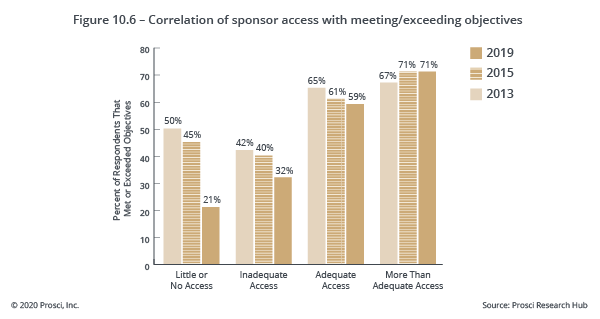
- Clearly define roles, responsibilities and relationships
Establish common expectations by clearly defining who does what, particularly between project manager and change practitioner roles. Identify areas of overlap to reduce potential role conflict. Maintain transparency and information access to foster better working relationships among team members. - Be present and involved
As a change management resource, stay actively engaged in project activities to gain a thorough understanding of how the solution will be designed, developed and deployed. This involvement enables you to better anticipate impacts and prepare stakeholders for the changes ahead.
Dimension 2: Process
This dimension addresses how the phases, activities and milestones of both disciplines align during the project lifecycle. Integration enables better information exchange, work sequencing, and alignment on timing.
The image below illustrates, at a high level, the alignment of the project management phases for a sequential change and the Prosci 3-Phase Process for change management. The image also shows how we align ADKAR milestones to project management milestones. For example, we align Ability for members of impacted groups with the Go Live milestone date. 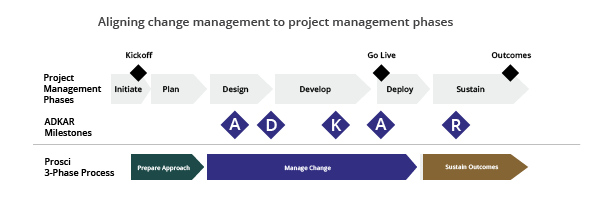 For optimal integration, begin change management activities early—ideally at project initiation. The earlier change management is started, the more effective exchanging information, sequencing work, and alignment on project milestone dates will be.
For optimal integration, begin change management activities early—ideally at project initiation. The earlier change management is started, the more effective exchanging information, sequencing work, and alignment on project milestone dates will be.
Using a process-driven approach with distinct deliverables for change management further improves the potential for successful change. If the change management approach is not process-driven with specific deliverables and milestones, it is difficult to integrate change management with project management effectively.
Action steps for integrating process
- Be structured in your approach
The more rigorous, process-oriented and milestone-driven your change management approach, the more easily it integrates with project management methods. A structured approach creates clear connection points between disciplines and ensures nothing falls through the cracks. - Define your deliverables
Capture change management work in specific, tangible deliverables to integrate effectively with the project management approach. Well-defined deliverables create accountability and demonstrate the value of change management activities to the project team. - Actively identify key points in time for integrating activities
Throughout the project lifecycle, identify critical moments when integrating activities, such as project milestone dates, is essential for change success. For each project milestone, determine which ADKAR elements must be in place. For example, before training (a project milestone), participants need Awareness of the need for change and Desire to participate (ADKAR elements). Knowledge and Ability follow from effective training.
Dimension 3: Tools
This dimension focuses on integrating specific tools and deliverables from both disciplines. Integration reduces duplication, creates collaboration opportunities, and promotes common understanding. For example, communications plans and risk assessments are tools commonly used by both disciplines. Integrating commonly used tools creates opportunities for collaboration between the disciplines, reduces duplication of effort and promotes common understanding.
Our research shows communications plans (91%), project plans (81%), and training plans (79%) are the most frequently integrated tools.
The following chart indicates which tools were most frequently integrated. Communications plans were integrated the most (91%), followed by project plans (81%) and training plans (79 %).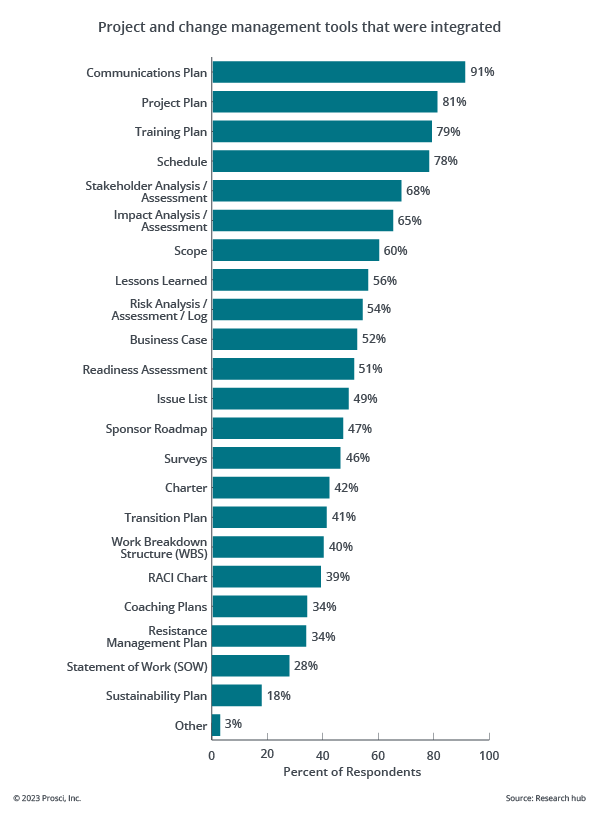
Action steps for integrating tools
- Identify specific tools that make sense for integration
Common tools to consider integrating include communications plans, training plans, stakeholder analyses, impact assessments, risk assessments and lessons learned. These project management tools can be adapted to include a change management perspective, creating a more comprehensive approach. - Work with what the project team has already done
Instead of dismissing existing project materials, build upon them. For example, rather than criticizing a communications plan for not addressing stakeholder concerns, show how it can be enhanced to answer questions impacted people care about: Why change? Why now? What if we don't? How will I be impacted? What's in it for me? This collaborative approach builds bridges rather than barriers. - Ensure clear ownership
When integrating tools, there's a risk that both change practitioners and project managers might inadvertently relinquish accountability. At the time of integration, clearly establish which role is accountable for each integrated tool to ensure nothing falls through the cracks.
Dimension 4: Methodologies
While the previous dimensions occur at the project level, methodology integration happens at the organizational level. This involves creating a standard approach to project delivery by combining your organization's project and change management methodologies.
Integrating methodologies involves decisions about when and how the methodologies interact and diverge. An integrated methodology is often part of a greater strategy for institutionalizing change management which Prosci defines as enterprise change management.
Action steps for integrating methodologies
- Select a common change management methodology
Before you can begin integration at the methodology level, your organization needs a standard change management methodology. A consistent approach creates a common language and set of practices across the organization. - Be mindful of the tradeoffs
When integrating at the methodology level, consider the risks of removing change management's responsive nature. Design your integrated methodology to maintain flexibility while providing structure, ensuring you can adapt to each project's unique needs. - Manage the change of introducing an integrated methodology
Many project managers may have limited experience with change management and are comfortable with their current methodology. When introducing a new integrated approach, apply change management principles to this change itself. This demonstrates the value of change management while increasing adoption of your integrated methodology.
Dimension 5: Results and Outcomes
Integration on this dimension acknowledges that change management and project management are complementary disciplines with a shared definition of success. In the end, both project management and change management improve the organization’s performance by helping it realize the benefits of making a change. This dimension focuses on establishing a shared definition of the results and outcomes for a specific change and how each discipline contributes to the achievement of those results and outcomes.
In many ways, this dimension is where integration begins. When we successfully integrate our view of what we're trying to achieve, other integration elements fall into place, creating a true team approach.
Action steps for integrating results and outcomes
- Define success for change management and project management
The project team must focus on and be accountable for delivering results in both change management and project management. If the team is only accountable for hitting the go-live date, integration will not succeed. Similarly, change management must define success in terms of achieving results, not simply executing activities like number of employees trained or communications delivered.
- Gain buy-in from project leaders and teams
Project leaders and managers may not understand the value of change management, or might view it as overhead that slows projects and consumes budget. To demonstrate value, determine the percentage of overall project results that depend on employee adoption and usage—the people-dependent portion of the return on investment. Show how addressing the people side of change will capture this critical portion of the ROI. - Connect project outcomes to organizational benefits
Both disciplines must work together to ensure project outcomes translate to organizational benefits. Technical success without adoption fails to deliver value, while strong adoption of a poorly designed solution creates its own problems. Integration ensures both aspects work together to achieve lasting results.
Meet Project Objectives and Achieve Success
Projects are more likely to succeed when we integrate change management and project management. An integrated approach increases the probability of achieving project objectives and sustaining outcomes. It enables project managers and change practitioners to work toward a shared definition of success, align activities effectively, and avoid duplicating efforts.
Change done right requires both strong technical implementation and effective people engagement—that's the power of integration.

